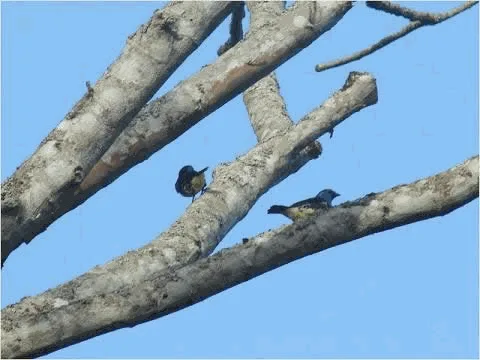 Turquoise Tanager  Turquoise Tanager (Tangara mexicana) [order] PASSERIFORMES | [family] Thraupidae | [latin] Tangara mexicana | [UK] Turquoise Tanager | [FR] Tangara turquoise | [DE] Turkistangare | [ES] Tangara Turquesa | [NL] Turkooistangare Subspecies
Physical charateristicsThey have long tails and dark stout bills. When fully grown, these tanagers are dark blue in color with yellow underparts. The Trinidadian form, T. m. vieiloti, has a darker blue hue and brighter yellow belly than their mainland counterparts. The east Brazilian subspecies, T. m. brasiliensis, is pale, silvery-blue with dark spots on its throat and chest and white on its belly Listen to the sound of Turquoise Tanager [audio:http://www.aviflevoland.nl/sounddb/T/Turquoise Tanager.mp3]
RangeSouth America : Amazonia, Southeast Brazil HabitatIt inhabits forests, semi-open areas, and cultivated lands. This bird typically builds a bulky cup nest in a tree or shrub. ReproductionThe nest is an open of dry grass, built fairly high up in the foliage of trees. The female Turquoise Tanager lays 2 to 3 brown-blotched, gray-green eggs per clutch. The female incubates the eggs for about 12 – 14 days. Pairs break off from the flock to reproduce. After hatching, pairs rejoin the flock but return to feed the young. Other adults may assist in rearing the young, Feeding habitsIt lives in groups of six birds, feeding on fruits and occasionally on insects. ConservationThis species has an extremely large range, and hence does not approach the thresholds for Vulnerable under the range size criterion (Extent of Occurrence <20,000 km2 combined with a declining or fluctuating range size, habitat extent/quality, or population size and a small number of locations or severe fragmentation). The population trend appears to be stable, and hence the species does not approach the thresholds for Vulnerable under the population trend criterion (>30% decline over ten years or three generations). The population size has not been quantified, but it is not believed to approach the thresholds for Vulnerable under the population size criterion (<10,000 mature individuals with a continuing decline estimated to be >10% in ten years or three generations, or with a specified population structure). For these reasons the species is evaluated as Least Concern.  MigrationSedentary throughout range Distribution map |
]]>
